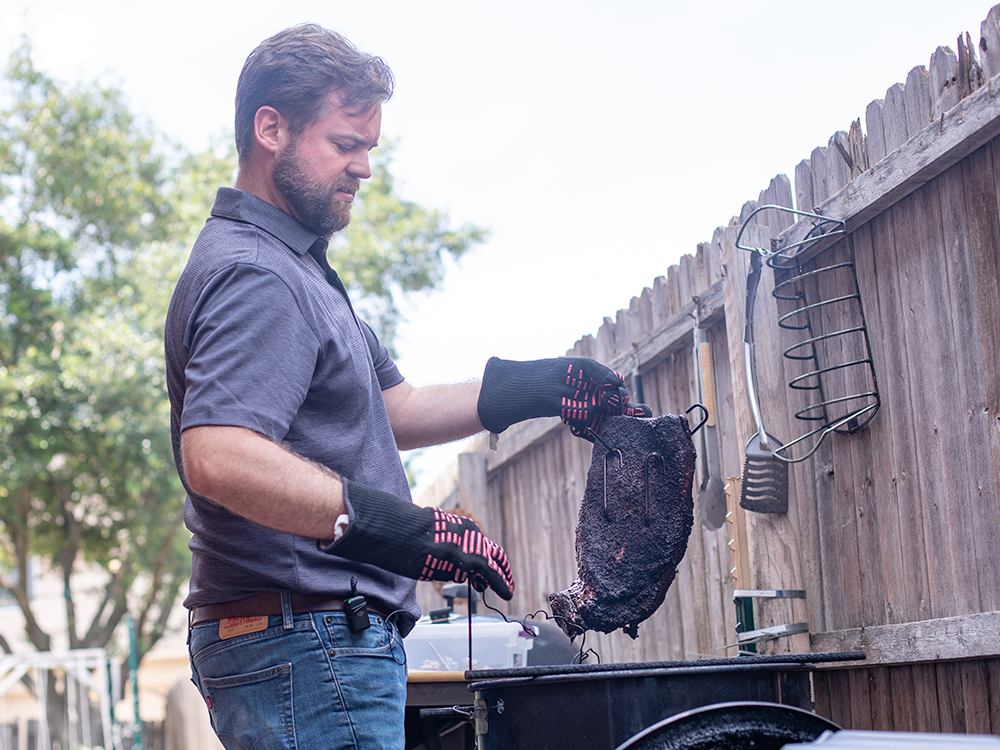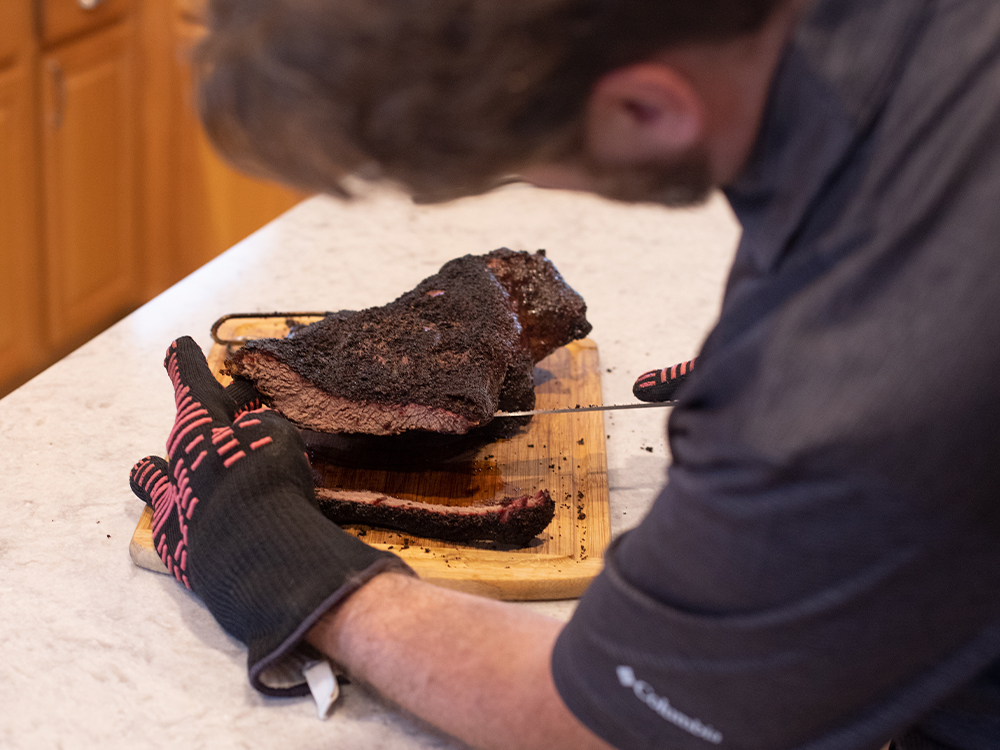The Science of BBQ: A ‘Complicated Circus of Chemicals’
06.15.2023
 Dr. Jeremiah Gassensmith, associate professor of chemistry and biochemistry at The University of Texas at Dallas, lifts a brisket after cooking it for eight hours in his backyard smoker.
Dr. Jeremiah Gassensmith, associate professor of chemistry and biochemistry at The University of Texas at Dallas, lifts a brisket after cooking it for eight hours in his backyard smoker.
Cooking the perfect brisket is a lot like conducting a science experiment. And Dr. Jeremiah Gassensmith should know — he’s both a chemist and backyard barbecue chef.
The challenge is to apply just the right amount of heat and at the right speed to melt proteins called collagen in the meat to transform a tough, muscular cut of beef into a classic Texas delicacy, said Gassensmith, associate professor of chemistry and biochemistry at The University of Texas at Dallas.
Gassensmith said collagens look like three strands of twisted yarn that loosen or untwist when they melt. Untwisted collagen binds with water, which moistens and lubricates the meat at temperatures between 160 and 180 degrees Fahrenheit. If you apply too little heat, the collagen won’t melt, and the meat will be chewy. If you add too much heat, the collagen strands tighten around each other, squeezing out all the water and making the meat dry.
“The chemistry is interesting,” Gassensmith said. “It comes down to how well you can make those proteins in the muscle do what you want them to do, as opposed to what they would like to do.”
Similar considerations go into creating hollandaise, Gassensmith said. If the heat is too low, the sauce resembles a soup made of raw eggs, whereas too much heat results in scrambled eggs. With the perfect amount of heat, however, the outcome is a delectable topping.
During the spring semester, Gassensmith taught a UT Dallas honors class, The Science & History of BBQ, which included lessons on how heat and smoke create texture and flavor. He said that brisket, which comes from the front of a cow’s chest, can be especially challenging to barbecue because it contains heavily worked muscle that the cow uses to stand.
“Hardworking muscles tend to have a lot of collagen, which is important for holding muscles together while in use so they do not tear easily,” Gassensmith said. “Collagen is also what makes meat tough if it isn’t cooked right.”
 Dr. Jeremiah Gassensmith, chemist and backyard barbecue chef, said the bark on the surface of the brisket forms when proteins slowly migrate from the muscle to the meat’s surface and create a tight matrix.
Dr. Jeremiah Gassensmith, chemist and backyard barbecue chef, said the bark on the surface of the brisket forms when proteins slowly migrate from the muscle to the meat’s surface and create a tight matrix.
Understanding the chemical interactions between smoke, proteins and water also can lead to a better brisket bark — the dark and flavorful crust that forms on the exterior of the meat as it cooks.
“Proteins slowly migrate from the muscle to the meat’s surface, then at high heat bind together with the rub onto the brisket, creating a tight matrix known as the bark,” Gassensmith said.
“To get a smoky flavor, the smoke has to have something to sit on and bind tightly with,” he said. “Smoke, which is actually an aerosol of water and minuscule particles of roasted wood, prefers to sit on a wet surface.”
For the best result, Gassensmith recommends spraying brisket with water rather than oil, which poorly interacts with smoke.
After smoking brisket for eight hours on a recent June day, Gassensmith wrapped it in butcher’s paper and cooked it for two more hours in the oven. He said wrapping the meat — sometimes called a Texas Crutch – traps water and prevents it from evaporating off the meat, which allows the temperature of the meat to reach the ideal temperature of around 200 degrees Fahrenheit.
Contrary to what many believe, resting brisket — letting it sit after cooking — will not help it reabsorb juices.
“Once the meat is cooked, it doesn’t take much of the liquids back in — that barn door has been shut. You’re just not going to get more absorption,” Gassensmith said.
Knowing a little science can help barbecue chefs avoid mistakes and even improve their skills. But science can only take them so far, Gassensmith said.
“There’s a very complicated circus of chemicals that you have to get just right to have the perfect brisket,” he said. “There is also the fat in the meat and myriad other factors that go into turning brisket into something amazing. The simplicity of brisket, being just a few ingredients, often fails to capture how complicated the resulting flavors are once it’s cooked. That is not science; that is art.”
–Kim Horner
Tags: Dr. Jeremiah Gassensmith, NSM